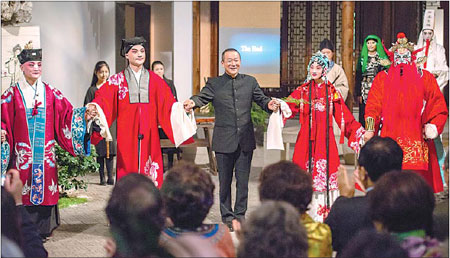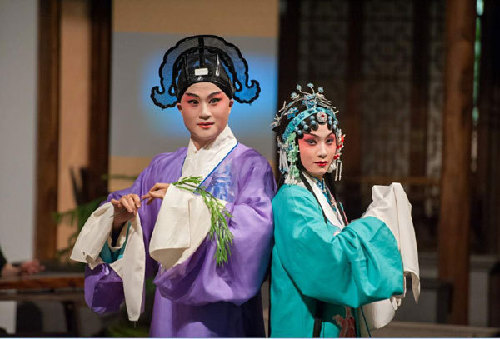
Academy Award winner and director of The Peony Pavilion Tan Dun greets the audience with cast members at the Astor Court in New York's Metropolitan Museum of Art.
Theatergoers know well that the venue is a key factor in the experience of watching a play. So when the Kunqu Opera classic Peony Pavilion was staged in the Chinese-style garden of the Metropolitan Museum of Art in New York it promised something very special for both its producers and audience.
On the night of November 30, 2012, the curtain lifted on the Kunqu Opera version of this 16th-century play directed by Oscar and Grammy winning composer Tan Dun. When it concluded 70 minutes later, the American audience gave it a standing ovation.
Kunqu’s Garden Stage
Kunqu Opera, with a history of more than 600 years, is considered to be the source of all Chinese folk operas, and was acknowledged by UNESCO as an “Oral and Intangible Heritage of Humanity,” the first Chinese cultural heritage to receive this recognition. Peony Pavilion, created by Ming Dynasty playwright Tang Xianzu (1550-1616) in 1598, remains an enduring piece in the Kunqu repertoire and has also been rendered in several other styles of folk opera.
The play tells of the strange romance between a man and a ghost. Young scholar Liu Mengmei and a magistrate’s daughter named Du Liniang meet in a dream and fall in love. Yearning for the boy she met in her dream Du buries a self-portrait beneath the rockery in a garden, and soon after the lovelorn girl dies of a broken heart.

Male and female leads Zhang Jun and Zhang Ran perform in The Peony Pavilion, composed and co-directed by Tan Dun, at New York's Metropolitan Museum of Art in December.
Three years later Liu comes to this very garden and discovers the picture. This, he realizes, was the girl he had dreamt of, and later Du returns to him in his dreams. His love for this mysterious girl moves him to reopen her tomb, and as the stale air stirs, Du comes back to life. Together at last, the couple meet vehement opposition from Du’s father, but their passion prevails and the play ends with their marriage.
In recent years, as traditional Chinese operas have regained popularity among Chinese viewers, there have been several versions of this story interpreted on the stage. The most successful retelling was a youth version by Suzhou Kunqu Opera House, a 90-minute adaptation first staged in a refurbished barn belonging to the Qing imperial court in Beijing.
Tan Dun’s offering has been referred to as the “garden” version because it débuted abroad in the Met’s Astor Court, whose design is based on the 12th-century Master-of-Nets (Wangshi) Garden in Suzhou. Free of the conventional array of props and stage, the performance unfurled among natural scenery, producing a fascinating atmosphere that was both realistic and fantastical. The accompanying music, with its ingenious imitation of the sound of flowing water created by the bamboo flute, Chinese lute, zither and percussion, deepened the ethereal atmosphere of the setting.
